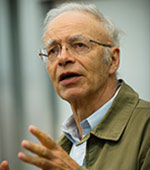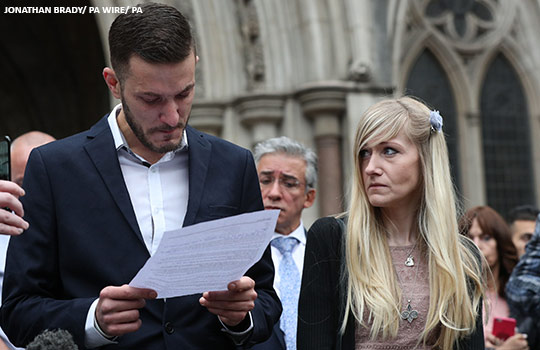We need to have an open debate about what we mean by best interests and how they are best served

 Charlie Gard died shortly before his first birthday after a long court battle over whether it was in his interests to receive experimental treatment. As ethicists, we were struck by how little of the public debate was about ethics.
Charlie Gard died shortly before his first birthday after a long court battle over whether it was in his interests to receive experimental treatment. As ethicists, we were struck by how little of the public debate was about ethics.
Despite the courts and the media focusing on the medical facts of the case, there was little medical disagreement. Arguing in favour of treatment, the US doctor, Dr Hirano, said back in April:
“His EEG is very severe. I think he is in the terminal stage of his illness . . . It is unlikely to work, but the alternative is that he will pass away.”
The treating doctor, Professor A’s testimony, confirmed that she and “Dr I [Hirano] did not really differ on the science and both agree that, very sadly, it is extremely unlikely to help Charlie.”
Yet Dr Hirano was willing to carry out a trial of treatment, but Professor A was not. Professor A put this down to a “cultural difference in philosophy between treatment in the United States and in the United Kingdom.” Is this relativism an adequate justification? We think not.
There are three justifications for withholding or withdrawing potentially life prolonging medical treatment: the patient validly refuses it (autonomy); the expected utility is too low to warrant the public resources necessary to provide it (distributive justice); or it is against the patient’s best interests (interests).
Autonomy is not relevant in Charlie’s case, but distributive justice would have precluded a trial of experimental treatment if it were to be funded from public funds. While nucleoside therapy is cheap, at least three months of intensive care would have been necessary, costing around £150 000. The best outcome estimated by Hirano was a 10% chance of a shortened life of severe disability. Fifty years of life at quality 0.3= 15 quality adjusted life years (QALYs), and so the expected value of a 10% chance of such a life is 1.5 QALYs. This would mean a cost of £100 000 per QALY, well over the current threshold of £30 000 per QALY.
This is a fair and reasonable ground for limiting treatment although the threshold itself is open to debate. However, the resources to cover the cost of treatment had been raised by Charlie’s parents, so there was no reason grounded in distributive justice to prevent Charlie travelling to the US to be treated there. Therefore, the only possible basis for withholding treatment was interests, which is significantly more complex.
A decision to withhold or withdraw treatment based on best interests can be framed in three ways: futility, the likelihood of success being too low, and the outcome being a life not worth living.
First, and most commonly used, is the argument that further treatment would be “futile.” Treatments can be futile for two reasons: either because the treatment has no scientific rationale, or because the patient’s condition is irreversible. In Charlie’s case there was a theoretical rationale, which both sets of doctors agreed on, leading to Great Ormond Street Hospital initially drafting an ethics committee application to try the treatment back in January before Charlie had several seizures. The chances of the treatment working were not zero and therefore, from a biological perspective, it was not futile.
Ultimately then, the decisive factor that brought an end to the legal proceedings was the view that his condition had become irreversible. The results of muscle scans performed in July led to general agreement between the doctors at Great Ormond Street Hospital, Dr Hirano, and the Vatican’s doctor that Charlie’s condition was irreversible, and his parents accepted this without requiring a further court decision.
Nevertheless, we cannot know exactly when Charlie’s injury became irreversible. Crucially, if a treatment might increase life expectancy, then it is a value judgment, not a medical or scientific judgment, as to whether such treatment is worthwhile, and this would depend on further factors discussed below.
If we reject the argument that further treatment is futile, it would still be possible to use the second line of argument on best interests: that the chance of improvement, although not zero, was too low.
The judge in Charlie’s case repeatedly equated the very low chance to zero chance. But Dr Hirano argued that the alternative was certain death, meaning that a “vanishingly small” chance is also the only chance. How should we decide what chance of improvement is too low? Is it 1%? 0.1%?
If there is also a very low probability that the treatment would cause severe or prolonged suffering, even an extremely low chance of improvement would make it reasonable to treat.
In Charlie’s case, this was a difficult question. His pain was managed without morphine initially and then a low dose of morphine, indicating that the best guess was a level of pain that was manageable, and therefore—even though the chances of success were very low—we believe it would have been reasonable to treat Charlie on this basis for a limited period.
If there was pain, Charlie was not spared it. From January to April, while the first case was being prepared and tried, and up until July when agreement was reached for treatment to be withdrawn, Charlie suffered the possible harms of the intensive care without the (small) possibility of benefit. It would be worth considering a new approach for that period of time to avoid this cruel irony.
The third way in which the treatment could be against a patient’s interests is that, even if it were “successful,” the best outcome that could be achieved is still not one worth aiming for—either in terms of length or quality of life. This is an area where there is very little agreement and much work to be done.
We are inclined to agree that the life that was predicted for Charlie, even if the treatment were to be successful, was not worth living. Many people, however, do not share our view.
They would hold that, as long as Charlie was conscious and capable of experiencing pleasure, then his life was worth living. Dr Hirano was reported in April saying that “if Charlie’s seizures were controlled he would presumably be able to interact with others, to smile, to look at objects, and to use his hands to grab objects.” For some, this would be a life worth living. Although we disagree, we accept that the claim such a life is a fate worse than death is not self-evident and so stands in need of justification.
In Charlie’s case, although the concept of a life not worth living appears to have been a factor in the decision (combined with the judge’s assessment that a very small theoretical chance of improvement was tantamount to no chance), no justification was attempted.
It is right that the decision over such cases should be made according to the best interests of the child, as the courts, parents, and doctors all tried to do in this case. But to do so, we need to unpick what we mean by best interests.
The doctors, courts, and many media commentators accepted the view that the proposed experimental treatment was not in Charlie Gard’s best interests. This was due in part to a narrative where one doctor was presented as making the right clinical judgment (that the brain damage was certainly irreversible) and another the wrong clinical judgment (that we did not know for sure whether or to what extent it was irreversible). Yet the disagreement—as Professor A indicated—appears to have been more philosophical in nature than medical: is a “vanishingly small” chance that some of the damage was reversible worth taking in the face of certain death? What level of improvement counts as a success? What degree of uncertainty over the pain suffered by the patient should we tolerate?
In matters of life and death, differences over best interests should not hang on cultural idiosyncrasies. Nor should we try to divine absolute answers about what we should do from clinical predictions about what might happen. In the absence of certainties, we should break down what we mean by best interests and engage in an open debate about how they are best served.
Julian Savulescu is Uehiro chair in practical ethics at the University of Oxford, visiting professorial fellow in biomedical ethics at the Murdoch Childrens Research Institute, and distinguished international visiting professor in law at Melbourne University.
Competing Interests: JS is editor of the Journal of Medical Ethics. JS was supported by a grant from the Wellcome Trust WT104848Z/14/Z. No other competing interests.
Peter Singer is Ira W DeCamp professor of bioethics at the University Centre for Human Values, Princeton University, and laureate professor in the School of Historical and Philosophical Studies at the University of Melbourne.
Competing interests: None declared.
References
Great Ormond Street Hospital v Yates, Gard and Gard [2017] EWHC 972 (Fam). https://www.judiciary.gov.uk/wp-content/uploads/2017/05/gosh-v-yates-and-gard-20170411-1.pdf
